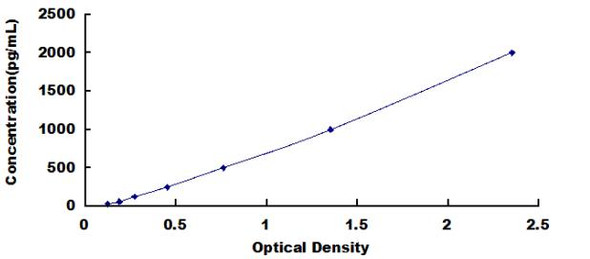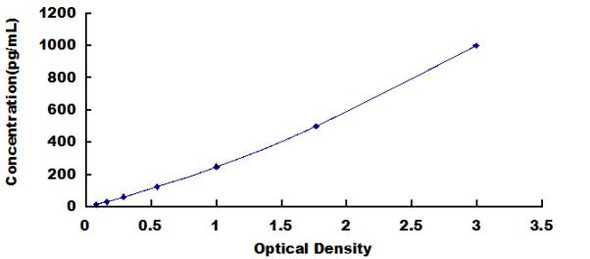Mouse Cell Signalling ELISA Kits 1
Mouse Transforming growth factor beta-1 (Tgfb1) ELISA Kit
- SKU:
- MOEB0118
- Product Type:
- ELISA Kit
- Size:
- 96 Assays
- Uniprot:
- P04202
- Range:
- 31.2-2000 pg/mL
- ELISA Type:
- Sandwich
- Synonyms:
- TGF-Beta1, Transforming Growth Factor Beta 1, TGF-B1, TGFB, TGFbeta, CED, DPD1, TGFBeta1
- Reactivity:
- Mouse
Description
| Product Name: | Mouse Transforming growth factor beta-1 (Tgfb1) ELISA Kit |
| Product Code: | MOEB0118 |
| Alias: | Transforming growth factor beta-1, TGF-beta-1, Tgfb1 |
| Uniprot: | P04202 |
| Reactivity: | Mouse |
| Range: | 31.2-2000 pg/mL |
| Detection Method: | Sandwich |
| Size: | 96 Assay |
| Storage: | Please see kit components below for exact storage details |
| Note: | For research use only |
| UniProt Protein Function: | TGFB1: Multifunctional protein that controls proliferation, differentiation and other functions in many cell types. Many cells synthesize TGFB1 and have specific receptors for it. It positively and negatively regulates many other growth factors. It plays an important role in bone remodeling as it is a potent stimulator of osteoblastic bone formation, causing chemotaxis, proliferation and differentiation in committed osteoblasts. Homodimer; disulfide-linked, or heterodimer with TGFB2. Secreted and stored as a biologically inactive form in the extracellular matrix in a 290 kDa complex (large latent TGF-beta1 complex) containing the TGFB1 homodimer, the latency-associated peptide (LAP), and the latent TGFB1 binding protein-1 (LTBP1). The complex without LTBP1 is known as the'small latent TGF-beta1 complex'. Dissociation of the TGFB1 from LAP is required for growth factor activation and biological activity. Release of the large latent TGF-beta1 complex from the extracellular matrix is carried out by the matrix metalloproteinase MMP3. May interact with THSD4; this interaction may lead to sequestration by FBN1 microfibril assembly and attenuation of TGFB signaling. Interacts with the serine proteases, HTRA1 and HTRA3: the interaction with either inhibits TGFB1-mediated signaling. The HTRA protease activity is required for this inhibition. Interacts with CD109, DPT and ASPN. Activated in vitro at pH below 3.5 and over 12.5. Highly expressed in bone. Abundantly expressed in articular cartilage and chondrocytes and is increased in osteoarthritis (OA). Co-localizes with ASPN in chondrocytes within OA lesions of articular cartilage. Belongs to the TGF-beta family. |
| UniProt Protein Details: | Protein type:Motility/polarity/chemotaxis; Secreted; Secreted, signal peptide Cellular Component: proteinaceous extracellular matrix; extracellular space; cell surface; microvillus; cell soma; cell; axon; cytoplasm; extracellular region; nucleus; secretory granule Molecular Function:protein binding; enzyme binding; protein homodimerization activity; growth factor activity; protein heterodimerization activity; punt binding; cytokine activity; protein N-terminus binding; glycoprotein binding; antigen binding; transforming growth factor beta receptor binding Biological Process: positive regulation of apoptosis; positive regulation of transcription, DNA-dependent; SMAD protein nuclear translocation; positive regulation of protein amino acid dephosphorylation; activation of NF-kappaB transcription factor; regulation of protein import into nucleus; positive regulation of MAP kinase activity; regulation of transforming growth factor beta receptor signaling pathway; negative regulation of ossification; cell cycle arrest; positive regulation of isotype switching to IgA isotypes; T cell differentiation; regulatory T cell differentiation; positive regulation of interleukin-17 production; regulation of CD4-positive, CD25-positive, alpha-beta regulatory T cell differentiation; positive regulation of smooth muscle cell differentiation; positive regulation of chemotaxis; negative regulation of immune response; positive regulation of blood vessel endothelial cell migration; regulation of sodium ion transport; negative regulation of blood vessel endothelial cell migration; negative regulation of fat cell differentiation; lymph node development; positive regulation of protein secretion; positive regulation of cell division; regulation of MAPKKK cascade; positive regulation of transcription from RNA polymerase II promoter; response to progesterone stimulus; endoderm development; positive regulation of odontogenesis; myelination; negative regulation of phagocytosis; evasion of host defenses by virus; T cell activation; wound healing; positive regulation of cellular protein metabolic process; myeloid dendritic cell differentiation; negative regulation of transcription from RNA polymerase II promoter; phosphate metabolic process; response to organic substance; negative regulation of cell proliferation; CD4-positive, CD25-positive, alpha-beta regulatory T cell lineage commitment; negative regulation of T cell proliferation; mammary gland development; regulation of DNA binding; negative regulation of release of sequestered calcium ion into cytosol; positive regulation of cell proliferation; protein kinase B signaling cascade; protein export from nucleus; inflammatory response; positive regulation of exit from mitosis; epidermal growth factor receptor signaling pathway; mitotic cell cycle checkpoint; common-partner SMAD protein phosphorylation; positive regulation of phosphoinositide 3-kinase activity; positive regulation of peptidyl-serine phosphorylation; SMAD protein complex assembly; regulation of cell proliferation; positive regulation of protein kinase B signaling cascade; cell proliferation; positive regulation of protein complex assembly; negative regulation of interleukin-17 production; positive regulation of protein import into nucleus; epithelial to mesenchymal transition; negative regulation of cell growth; negative regulation of cell-cell adhesion; negative regulation of skeletal muscle development; mononuclear cell proliferation; protein amino acid phosphorylation; hyaluronan catabolic process; regulation of apoptosis; negative regulation of neuroblast proliferation; transforming growth factor beta receptor signaling pathway; receptor catabolic process; positive regulation of superoxide release; germ cell migration; chondrocyte differentiation; defense response to fungus, incompatible interaction; T cell homeostasis; negative regulation of mitotic cell cycle; cell growth; tolerance induction to self antigen; regulation of striated muscle development; organ regeneration; skeletal muscle development; cell activation; organ morphogenesis; negative regulation of DNA replication; hemopoietic progenitor cell differentiation; negative regulation of transcription, DNA-dependent; positive regulation of epithelial cell proliferation; positive regulation of collagen biosynthetic process; defense response; response to estradiol stimulus; negative regulation of cell cycle; regulation of interleukin-23 production; positive regulation of histone deacetylation; negative regulation of protein amino acid phosphorylation; lipopolysaccharide-mediated signaling pathway; adaptive immune response based on somatic recombination of immune receptors built from immunoglobulin superfamily domains; skeletal development; negative regulation of epithelial cell proliferation; intercellular junction assembly and maintenance; regulation of binding; MAPKKK cascade; morphogenesis of a branching structure; cellular calcium ion homeostasis; protein import into nucleus, translocation; ATP biosynthetic process; positive regulation of histone acetylation; positive regulation of protein amino acid phosphorylation; negative regulation of myoblast differentiation; negative regulation of T cell activation; growth; positive regulation of cell migration |
| UniProt Code: | P04202 |
| NCBI GenInfo Identifier: | 135675 |
| NCBI Gene ID: | 21803 |
| NCBI Accession: | P04202.1 |
| UniProt Related Accession: | P04202 |
| Molecular Weight: | 44,310 Da |
| NCBI Full Name: | Transforming growth factor beta-1 |
| NCBI Synonym Full Names: | transforming growth factor, beta 1 |
| NCBI Official Symbol: | Tgfb1 |
| NCBI Official Synonym Symbols: | Tgfb; Tgfb-1; TGFbeta1; TGF-beta1 |
| NCBI Protein Information: | transforming growth factor beta-1; TGF-beta 1; TGF-beta-1; regulatory protein; transforming growth factor-beta 1 |
| UniProt Protein Name: | Transforming growth factor beta-1 |
| UniProt Synonym Protein Names: | |
| Protein Family: | Transforming growth factor |
| UniProt Gene Name: | Tgfb1 |
| UniProt Entry Name: | TGFB1_MOUSE |
| Component | Quantity (96 Assays) | Storage |
| ELISA Microplate (Dismountable) | 8×12 strips | -20°C |
| Lyophilized Standard | 2 | -20°C |
| Sample Diluent | 20ml | -20°C |
| Assay Diluent A | 10mL | -20°C |
| Assay Diluent B | 10mL | -20°C |
| Detection Reagent A | 120µL | -20°C |
| Detection Reagent B | 120µL | -20°C |
| Wash Buffer | 30mL | 4°C |
| Substrate | 10mL | 4°C |
| Stop Solution | 10mL | 4°C |
| Plate Sealer | 5 | - |
Other materials and equipment required:
- Microplate reader with 450 nm wavelength filter
- Multichannel Pipette, Pipette, microcentrifuge tubes and disposable pipette tips
- Incubator
- Deionized or distilled water
- Absorbent paper
- Buffer resevoir
*Note: The below protocol is a sample protocol. Protocols are specific to each batch/lot. For the correct instructions please follow the protocol included in your kit.
Allow all reagents to reach room temperature (Please do not dissolve the reagents at 37°C directly). All the reagents should be mixed thoroughly by gently swirling before pipetting. Avoid foaming. Keep appropriate numbers of strips for 1 experiment and remove extra strips from microtiter plate. Removed strips should be resealed and stored at -20°C until the kits expiry date. Prepare all reagents, working standards and samples as directed in the previous sections. Please predict the concentration before assaying. If values for these are not within the range of the standard curve, users must determine the optimal sample dilutions for their experiments. We recommend running all samples in duplicate.
| Step | |
| 1. | Add Sample: Add 100µL of Standard, Blank, or Sample per well. The blank well is added with Sample diluent. Solutions are added to the bottom of micro ELISA plate well, avoid inside wall touching and foaming as possible. Mix it gently. Cover the plate with sealer we provided. Incubate for 120 minutes at 37°C. |
| 2. | Remove the liquid from each well, don't wash. Add 100µL of Detection Reagent A working solution to each well. Cover with the Plate sealer. Gently tap the plate to ensure thorough mixing. Incubate for 1 hour at 37°C. Note: if Detection Reagent A appears cloudy warm to room temperature until solution is uniform. |
| 3. | Aspirate each well and wash, repeating the process three times. Wash by filling each well with Wash Buffer (approximately 400µL) (a squirt bottle, multi-channel pipette,manifold dispenser or automated washer are needed). Complete removal of liquid at each step is essential. After the last wash, completely remove remaining Wash Buffer by aspirating or decanting. Invert the plate and pat it against thick clean absorbent paper. |
| 4. | Add 100µL of Detection Reagent B working solution to each well. Cover with the Plate sealer. Incubate for 60 minutes at 37°C. |
| 5. | Repeat the wash process for five times as conducted in step 3. |
| 6. | Add 90µL of Substrate Solution to each well. Cover with a new Plate sealer and incubate for 10-20 minutes at 37°C. Protect the plate from light. The reaction time can be shortened or extended according to the actual color change, but this should not exceed more than 30 minutes. When apparent gradient appears in standard wells, user should terminatethe reaction. |
| 7. | Add 50µL of Stop Solution to each well. If color change does not appear uniform, gently tap the plate to ensure thorough mixing. |
| 8. | Determine the optical density (OD value) of each well at once, using a micro-plate reader set to 450 nm. User should open the micro-plate reader in advance, preheat the instrument, and set the testing parameters. |
| 9. | After experiment, store all reagents according to the specified storage temperature respectively until their expiry. |
When carrying out an ELISA assay it is important to prepare your samples in order to achieve the best possible results. Below we have a list of procedures for the preparation of samples for different sample types.
| Sample Type | Protocol |
| Serum | If using serum separator tubes, allow samples to clot for 30 minutes at room temperature. Centrifuge for 10 minutes at 1,000x g. Collect the serum fraction and assay promptly or aliquot and store the samples at -80°C. Avoid multiple freeze-thaw cycles. If serum separator tubes are not being used, allow samples to clot overnight at 2-8°C. Centrifuge for 10 minutes at 1,000x g. Remove serum and assay promptly or aliquot and store the samples at -80°C. Avoid multiple freeze-thaw cycles. |
| Plasma | Collect plasma using EDTA or heparin as an anticoagulant. Centrifuge samples at 4°C for 15 mins at 1000 × g within 30 mins of collection. Collect the plasma fraction and assay promptly or aliquot and store the samples at -80°C. Avoid multiple freeze-thaw cycles. Note: Over haemolysed samples are not suitable for use with this kit. |
| Urine & Cerebrospinal Fluid | Collect the urine (mid-stream) in a sterile container, centrifuge for 20 mins at 2000-3000 rpm. Remove supernatant and assay immediately. If any precipitation is detected, repeat the centrifugation step. A similar protocol can be used for cerebrospinal fluid. |
| Cell culture supernatant | Collect the cell culture media by pipette, followed by centrifugation at 4°C for 20 mins at 1500 rpm. Collect the clear supernatant and assay immediately. |
| Cell lysates | Solubilize cells in lysis buffer and allow to sit on ice for 30 minutes. Centrifuge tubes at 14,000 x g for 5 minutes to remove insoluble material. Aliquot the supernatant into a new tube and discard the remaining whole cell extract. Quantify total protein concentration using a total protein assay. Assay immediately or aliquot and store at ≤ -20 °C. |
| Tissue homogenates | The preparation of tissue homogenates will vary depending upon tissue type. Rinse tissue with 1X PBS to remove excess blood & homogenize in 20ml of 1X PBS (including protease inhibitors) and store overnight at ≤ -20°C. Two freeze-thaw cycles are required to break the cell membranes. To further disrupt the cell membranes you can sonicate the samples. Centrifuge homogenates for 5 mins at 5000xg. Remove the supernatant and assay immediately or aliquot and store at -20°C or -80°C. |
| Tissue lysates | Rinse tissue with PBS, cut into 1-2 mm pieces, and homogenize with a tissue homogenizer in PBS. Add an equal volume of RIPA buffer containing protease inhibitors and lyse tissues at room temperature for 30 minutes with gentle agitation. Centrifuge to remove debris. Quantify total protein concentration using a total protein assay. Assay immediately or aliquot and store at ≤ -20 °C. |
| Breast Milk | Collect milk samples and centrifuge at 10,000 x g for 60 min at 4°C. Aliquot the supernatant and assay. For long term use, store samples at -80°C. Minimize freeze/thaw cycles. |






